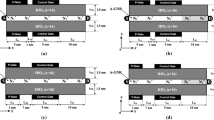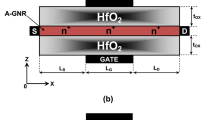Abstract
As the channel length shrinks below the 10-nm regime, emerging materials, junctionless technology, and multiple-gate geometries provide an excellent combination to continue progress towards lower-cost high-performance ultrascaled devices. In this study, the double-gate junctionless (JL) graphene nanoribbon field-effect transistor (GNRFET) and its conventional counterpart (C-GNRFET) are compared in terms of short-channel effects (SCEs) using a quantum simulation. The computational approach is based on solving the Schrödinger equation using the mode-space nonequilibrium Green’s function formalism coupled self-consistently with a Poisson equation in the ballistic limit. The analysis of gate length downscaling shows that the JL GNRFET exhibits better leakage current, subthreshold swing (SS), drain-induced barrier lowering, and threshold voltage roll-off in comparison with the conventional GNRFET. In addition, we reveal that a decrease in the n-type doping concentration can enhance the above-mentioned characteristics of both devices. The results indicate that the JL GNRFET can mitigate critical issues and enhance the immunity to SCEs of the GNRFET, making it a promising candidate for high-performance ultrascaled (sub-5-nm) technology.








Similar content being viewed by others
References
Lee, C.-W., Afzalian, A., Akhavan, N.D., Yan, R., Ferain, I., Colinge, J.-P.: Junctionless multigate field-effect transistor. Appl. Phys. Lett. 94(5), 053511 (2009). https://doi.org/10.1063/1.3079411
Colinge, J.-P., Lee, C.-W., Afzalian, A., Akhavan, N.D., Yan, R., Ferain, I., Razavi, P., O’Neill, B., Blake, A., White, M., Kelleher, A.-M., McCarthy, B., Murphy, R.: Nanowire transistors without junctions. Nat. Nanotechnol. 5(3), 225–229 (2010). https://doi.org/10.1038/nnano.2010.15
Lee, C.-W., Ferain, I., Afzalian, A., Yan, R., Akhavan, N.D., Razavi, P., Colinge, J.-P.: Performance estimation of junctionless multigate transistors. Solid-State Electron. 54(2), 97–103 (2010). https://doi.org/10.1016/j.sse.2009.12.003
Lou, H., Zhang, L., Zhu, Y., Lin, X., Yang, S., He, J., Chan, M.: A junctionless nanowire transistor with a dual-material gate. IEEE Trans. Electron Devices 59(7), 1829–1836 (2012). https://doi.org/10.1109/TED.2012.2192499
Han, M.-H., Chang, C.-Y., Chen, H.-B., Wu, J.-J., Cheng, Y.-C., Wu, Y.-C.: Performance comparison between bulk and SOI junctionless transistors. IEEE Electron Device Lett. 34(2), 169–171 (2013). https://doi.org/10.1109/LED.2012.2231395
Ansari, L., Feldman, B., Fagas, G., Colinge, J.-P., Greer, J.C.: Simulation of junctionless Si nanowire transistors with 3 nm gate length. Appl. Phys. Lett. 97(6), 062105 (2010). https://doi.org/10.1063/1.3478012
Barraud, S., Berthome, M., Coquand, R., Casse, M., Ernst, T., Samson, M.-P., Perreau, P., Bourdelle, K.K., Faynot, O., Poiroux, T.: Scaling of trigate junctionless nanowire MOSFET With gate length down to 13 nm. IEEE Electron Device Lett. 33(9), 1225–1227 (2012). https://doi.org/10.1109/LED.2012.2203091
Agarwal, T., Sorée, B., Radu, I., Raghavan, P., Fiori, G., Iannaccone, G., Thean, A., Heyns, M., Dehaene, W.: Comparison of short-channel effects in monolayer MoS2 based junctionless and inversion-mode field-effect transistors. Appl. Phys. Lett. 108(2), 023506 (2016). https://doi.org/10.1063/1.4939933
Guo, J.: Modeling of graphene nanoribbon devices. Nanoscale 4(18), 5538–5548 (2012). https://doi.org/10.1039/C2NR31437A
Wang, X., Ouyang, Y., Li, X., Wang, H., Guo, J., Dai, H.: Room-temperature all-semiconducting sub-10-nm graphene nanoribbon field-effect transistors. Phys. Rev. Lett. 100(20), 206803 (2008). https://doi.org/10.1103/PhysRevLett.100.206803
Llinas, J.P., Fairbrother, A., Borin Barin, G., Shi, W., Lee, K., Wu, S., Yong Choi, B., Braganza, R., Lear, J., Kau, N., Choi, W., Chen, C., Pedramrazi, Z., Dumslaff, T., Narita, A., Feng, X., Müllen, K., Fischer, F., Zettl, A., Ruffieux, P., Yablonovitch, E., Crommie, M., Fasel, R., Bokor, J.: Short-channel field-effect transistors with 9-atom and 13-atom wide graphene nanoribbons. Nat. Commun. (2017). https://doi.org/10.1038/s41467-017-00734-x
Marmolejo-Tejada, J.M., Velasco-Medina, J.: Review on graphene nanoribbon devices for logic applications. Microelectron. J. 48, 18–38 (2016). https://doi.org/10.1016/j.mejo.2015.11.006
Barik, M.A., Deka, R., Dutta, J.C.: Carbon nanotube-based dual-gated junctionless field-effect transistor for acetylcholine detection. IEEE Sens. J. 16(2), 280–286 (2016). https://doi.org/10.1109/JSEN.2015.2481604
Barik, M.A., Dutta, J.C.: Fabrication and characterization of junctionless carbon nanotube field effect transistor for cholesterol detection. Appl. Phys. Lett. 105(5), 053509 (2014). https://doi.org/10.1063/1.4892469
Ansari, L., Feldman, B., Fagas, G., Lacambra, C.M., Haverty, M.G., Kuhn, K.J., Shankar, S., Greer, J.C.: First principle-based analysis of single-walled carbon nanotube and silicon nanowire junctionless transistors. IEEE Trans. Nanotechnol. 12(6), 1075–1081 (2013). https://doi.org/10.1109/TNANO.2013.2279424
Barbastegan, S., Shahhoseini, A.: Performance analysis of junctionless carbon nanotube field effect transistors using NEGF formalism. Mod. Phys. Lett. B 30(10), 1650125 (2016). https://doi.org/10.1142/S0217984916501256
Pourian, P., Yousefi, R., Ghoreishi, S.S.: Effect of uniaxial strain on electrical properties of CNT-based junctionless field-effect transistor: numerical study. Superlattices Microstruct. 93, 92–100 (2016). https://doi.org/10.1016/j.spmi.2016.03.014
Bala, S., Khosla, M.: Design and analysis of electrostatic doped tunnel CNTFET for various process parameters variation. Superlattices Microstruct. 124, 160–167 (2018). https://doi.org/10.1016/j.spmi.2018.10.007
Guo, J., Datta, S., Lundstrom, M., Anantam, M.P.: Toward multiscale modeling of carbon nanotube transistors. Int. J. Multisc. Comput. Eng. 2(2), 257–276 (2004). https://doi.org/10.1615/IntJMultCompEng.v2.i2.60
Koswatta, S.O., Lundstrom, M.S., Anantram, M.P., Nikonov, D.E.: Simulation of phonon-assisted band-to-band tunneling in carbon nanotube field-effect transistors. Appl. Phys. Lett. 87(25), 253107 (2005). https://doi.org/10.1063/1.2146065
Koswatta, S.O., Nikonov, D.E., Lundstrom, M.S.: Computational study of carbon nanotube p–i–n tunnel FETs. In: IEEE International Electron Devices Meeting. IEDM Technical Digest, pp. 518–521 (2005). https://doi.org/10.1109/IEDM.2005.1609396
Zhao, P., Guo, J.: Modeling edge effects in graphene nanoribbon field-effect transistors with real and mode space methods. J. Appl. Phys. 105(3), 034503-1–034503-7 (2009). https://doi.org/10.1063/1.3073875
Son, Y.-W., Cohen, M.L., Louie, S.G.: Energy gaps in graphene nanoribbons. Phys. Rev. Lett. 97(21), 216803-1–216803-4 (2006). https://doi.org/10.1103/PhysRevLett.97.216803
Chin, S.-K., Seah, D., Lam, K.-T., Samudra, G.S., Liang, G.: Device physics and characteristics of graphene nanoribbon tunneling FETs. IEEE Trans. Electron Devices 57(11), 3144–3152 (2010). https://doi.org/10.1109/TED.2010.2065809
Tamersit, K., Djeffal, F.: Double-gate graphene nanoribbon field-effect transistor for DNA and gas sensing applications: simulation study and sensitivity analysis. IEEE Sensors J. 16(11), 4180–4191 (2016). https://doi.org/10.1109/JSEN.2016.2550492
Tamersit, K., Djeffal, F.: Boosting the performance of a nanoscale graphene nanoribbon field-effect transistor using graded gate engineering. J. Comput. Electron. 17(3), 1276–1284 (2018). https://doi.org/10.1007/s10825-018-1209-6
Datta, S.: Nanoscale device modeling: the Green’s function method. Superlattices Microstruct. 28(4), 253–278 (2000). https://doi.org/10.1006/spmi.2000.0920
Anantram, M.P., Lundstrom, M.S., Nikonov, D.E.: Modeling of nanoscale devices. Proc. IEEE 96(9), 1511–1550 (2008). https://doi.org/10.1109/JPROC.2008.927355
Tamersit, K., Djeffal, F.: A novel graphene field-effect transistor for radiation sensing application with improved sensitivity: proposal and analysis. Nucl. Instrum. Methods Phys. Res. Sect. A 901, 32–39 (2018). https://doi.org/10.1016/j.nima.2018.05.075
Ortiz-Conde, A., Garcı́a Sánchez, F.J., Liou, J.J., Cerdeira, A., Estrada, M., Yue, Y.: A review of recent MOSFET threshold voltage extraction methods. Microelectron. Reliab. 42(4–5), 583–596 (2002). https://doi.org/10.1016/S0026-2714(02)00027-6
Fiori, G., Iannaccone, G.: Simulation of graphene nanoribbon field-effect transistors. IEEE Electron Device Lett. 28(8), 760–762 (2007). https://doi.org/10.1109/LED.2007.901680
Tamersit, K.: Quantum simulation of a junctionless carbon nanotube field-effect transistor with binary metal alloy gate electrode. Superlattices Microstruct. 128, 252–259 (2019). https://doi.org/10.1016/j.spmi.2019.02.001
Naderi, A., Tahne, B.A.: Review—methods in improving the performance of carbon nanotube field effect transistors. ECS J. Solid State Sci. Technol. 5(12), M131–M140 (2016). https://doi.org/10.1149/2.0021612jss
Naderi, A., Keshavarzi, P.: Electrically-activated source extension graphene nanoribbon field effect transistor: novel attributes and design considerations for suppressing short channel effects. Superlattices Microstruct. 72, 305–318 (2014). https://doi.org/10.1016/j.spmi.2014.05.003
Yousefi, R., Shabani, M., Arjmandi, M., Ghoreishi, S.S.: A computational study on electrical characteristics of a novel band-to-band tunneling graphene nanoribbon FET. Superlattices Microstruct. 60, 169–178 (2013). https://doi.org/10.1016/j.spmi.2013.05.003
Naderi, A.: Theoretical analysis of a novel dual gate metal–graphene nanoribbon field effect transistor. Mater. Sci. Semicond. Process. 31, 223–228 (2015). https://doi.org/10.1016/j.mssp.2014.11.051
Akbari Eshkalak, M., Anvarifard, M.K.: A novel graphene nanoribbon FET with an extra peak electric field (EFP-GNRFET) for enhancing the electrical performances. Phys. Lett. A 381(16), 1379–1385 (2017). https://doi.org/10.1016/j.physleta.2017.02.032
Ouyang, Y., Yoon, Y., Guo, J.: Scaling behaviors of graphene nanoribbon FETs: a three-dimensional quantum simulation study. IEEE Trans. Electron Devices 54(9), 2223–2231 (2007). https://doi.org/10.1109/TED.2007.902692
Owlia, H., Keshavarzi, P.: Investigation of the novel attributes of a double-gate graphene nanoribbon FET with AlN high-κ dielectrics. Superlattices Microstruct. 75, 613–620 (2014). https://doi.org/10.1016/j.spmi.2014.09.003
Akbari Eshkalak, M., Faez, R., Haji-Nasiri, S.: A novel graphene nanoribbon field effect transistor with two different gate insulators. Physica E 66, 133–139 (2015). https://doi.org/10.1016/j.physe.2014.10.021
Tamersit, K.: Performance assessment of a new radiation dosimeter based on carbon nanotube field-effect transistor: a quantum simulation study. IEEE Sens. J. 19(9), 3314–3321 (2019). https://doi.org/10.1109/JSEN.2019.2894440
Rawat, B., Paily, R.: Modeling of graphene-based field-effect transistors through a 1-D real-space approach. J. Comput. Electron. 17(1), 90–100 (2017). https://doi.org/10.1007/s10825-017-1069-5
Tamersit, K.: An ultra-sensitive gas nanosensor based on asymmetric dual-gate graphene nanoribbon field-effect transistor: proposal and investigation. J. Comput. Electron. (2019). https://doi.org/10.1007/s10825-019-01349-9
Tamersit, K., Djeffal, F.: A computationally efficient hybrid approach based on artificial neural networks and the wavelet transform for quantum simulations of graphene nanoribbon FETs. J. Comput. Electron. (2019). https://doi.org/10.1007/s10825-019-01350-2
Author information
Authors and Affiliations
Corresponding author
Additional information
Publisher's Note
Springer Nature remains neutral with regard to jurisdictional claims in published maps and institutional affiliations.
Appendix
Appendix
The appendix of this paper is devoted to presenting the main equations of the quantum simulation described herein to solve the MS NEGF–Poisson system self-consistently. More details regarding the computational approach applied can be found in Refs. [41,42,43,44]. The NEGF-based atomistic simulation is principally based on the numerical computation of the famous retarded Green’s function, which can be determined by [27]
where I, E, H, and ΣS(D) are the identity matrix, energy, Hamiltonian matrix (H is based on the atomistic nearest neighbor pz-orbital TB estimation [22]), and the source (drain) self-energy, respectively. Note that 0+ is an infinitesimal value, positively fixed. It is worth indicating that the Hamiltonian has a size of (M × M), where M is the number of columns (lines) of carbon atoms in the x direction [22, 25]. Note also that the self-energy matrices have the same size as the Hamiltonian and only the (1, 1) element of ΣS and the (M, M) element of ΣD are nonzero [26]. As seen in Eq. (1), ballistic transport is normally assumed. It is worth indicating that the self-energies can be computed analytically [22]. The local density of states (LDOS) resulting from the source (drain) injected states is computed using [22, 27]
Note that the energy level broadening ΓS(D) due to the source (drain) contact is given by [22, 27]
Based on the source/drain LDOS, the charge density is then computed as [22]
where q, sgn, f, EFS(FD), and EN(x) are the electron charge, sign function, Fermi function, source (drain) Fermi level, and charge neutrality level, respectively. Note that the charge neutrality level EN(x) lies at the middle of the bandgap because the conduction and valence band of an armchair-edge graphene nanoribbon are symmetric [38]. In the Poisson solver, the self-consistent electrostatic potential is calculated from the electrode potentials and the GNR charge density using the Poisson equation [26, 37]
where U, ρ, and ε are the electrostatic potential within the GNRFET, the distribution of the charge density including the doping density [22, 25, 28], and the dielectric constant, respectively. Note that the discrete nature of the dopants is not taken into account and could be a subject for further investigations. The finite difference method (FDM) is used to solve Eq. (5), where the grid spacing used (in the 2D FDM discretization) is taken to be equal to 1 Å in both the x- and y-direction [25, 41]. After the convergence of the self-consistent system, the source–drain current is calculated as [22]
where ħ, q, and T(E) = Tr[ΓSGΓDG†] are the Planck constant, electron charge, and transmission coefficient, respectively.
Rights and permissions
About this article
Cite this article
Tamersit, K. A computational study of short-channel effects in double-gate junctionless graphene nanoribbon field-effect transistors. J Comput Electron 18, 1214–1221 (2019). https://doi.org/10.1007/s10825-019-01375-7
Published:
Issue Date:
DOI: https://doi.org/10.1007/s10825-019-01375-7




